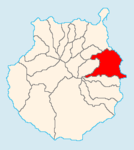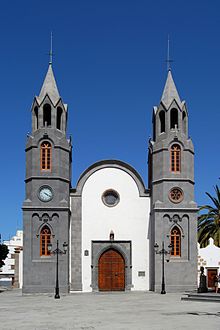Telde
| Telde municipality | ||
|---|---|---|
| coat of arms | Map of the Canary Islands | |

|
|
|
| Basic data | ||
| Autonomous Community : | Canary Islands | |
| Province : | Las Palmas | |
| Island: | Gran Canaria | |
| Coordinates | 28 ° 0 ′ N , 15 ° 25 ′ W | |
| Height : | 130 msnm | |
| Area : | 102.43 km² | |
| Residents : | 102,647 (Jan. 1, 2019) | |
| Population density : | 1,002.12 inhabitants / km² | |
| Postal code : | E-35200 | |
| Municipality number ( INE ): | 35026 | |
| Nearest airport : | Gran Canaria Airport | |
| administration | ||
| Mayor : | María del Carmen Castellano Rodríguez ( PP ) | |
| Address of the municipal administration: | Plaza de San Juan, 1 35200 - Telde |
|
| Website : | www.telde.es | |
| Location of the municipality | ||

|
||
Telde is a city on the Canary Island of Gran Canaria . Telde has 102,647 inhabitants (as of January 1, 2019) on an area of 102.43 km². The former capital is now the second largest city on the island. Gran Canaria's international airport is located near the municipality of Gando .
Telde is about 15 kilometers south of Las Palmas de Gran Canaria . The neighboring municipalities are Las Palmas de Gran Canaria in the north, Ingenio in the south, Valsequillo in the west and Santa Brígida in the northwest.
Residents
| year | Residents | Population density |
|---|---|---|
| 1991 | 77,356 | NN |
| 1996 | 84,389 | NN |
| 2001 | 87,949 | 862.2 inhabitants / km² |
| 2002 | 91.160 | NN |
| 2003 | 93,942 | 917.1 inhabitants / km² |
| 2004 | 94,862 | 922.1 inhabitants / km² |
| 2005 | 96,547 | 942.6 inhabitants / km² |
history
Archaeological finds (ceramic shards, etc.) and the report by Leonardo Torriani , who visited the island about 100 years after the Spanish conquest, suggest that Telde was an important market center in addition to its political importance. Telde then consisted of two localities: Tara and Cendro . In the area of the former Tara, one of the most important testimonies of the Canarios culture (indigenous people of Gran Canaria) was found, the apparently female cult figure " Idolo de Tara ". In the period from 1351 to 1393 Telde was the seat of the bishop of the Happy Islands (Fortunatae Insulae).
After the Spanish conquest of the island, the island administration founded the place Telde with the center San Francisco in the north of the present city and the settlement Los Llanos south of it.
While the Spanish population settled in the northern part around the administrative center, the Franciscan monastery and the parish church of San Juan Bautista, and wealthy traders built their properties, black slaves were living in Los Llanos in Africa . These were used to work on the sugar cane plantations and in the sugar mills in the region and thus increased the prosperity of the upper class of Telde. One of the most important slave markets in the Canary Islands also took place here: the slaves were offered, appraised and sold in a humiliating manner like cattle.
The city developed into the most important settlement on the island after Las Palmas and also benefited from its proximity to the capital. Because of its inland location, it was also safe in the event of attacks by the privateers who frequently raided the Canary Islands. In 1836 the Franciscans (OFM) were expelled from Telde. In 1843 the engineer Juan León y Castillo was born in Telde , who later carried out the expansion and modernization of the port of Las Palmas. In the 20th century Telde, like the whole island, had to cope with an economic decline. The situation only recovered with the construction and multiple expansions of the international airport in the east of the district. Today Telde is the seat of many Canarian companies.
Attractions
The historical sights are concentrated in the old town of Telde, the Barrio San Francisco in the north of the city area. The city's parish church of San Juan Bautista, which is dedicated to John the Baptist ( 28 ° 0 ′ 11.7 ″ N , 15 ° 24 ′ 50 ″ W ), is the most important sight in the city and one of the most valuable sacred buildings on the island . The construction of the three-aisled church made of differently colored volcanic rock began around 1520; the late Gothic main facade is still from the 16th century. In the 17th and 18th centuries structural changes in the Baroque style were made and in the 19th century the central nave was renewed. The two bell towers were not erected until the 20th century.
In the interior of the church, the Flemish reredos of the high altar, which was created around 1500 and shows six scenes from the life of the Blessed Virgin Mary , the Mother of God : the birth of Jesus Christ, the marriage of Mary to Joseph , the Annunciation by the Archangel Gabriel , the Visitation, is significant in terms of art history Mary , the circumcision of Jesus and the adoration of the Magi . The Christ on the cross of the high altar was made from maize pulp in Mexico in the 16th century and therefore weighs only 7 kg despite its life size. The depiction of St. Bernard is the work of Vicente Carducci (1578–1638), several sculptures in the church are by Luján Pérez .
Also in the old town is the Museo León y Castillo , in an old Canarian mansion with wooden balconies and courtyard , which is dedicated to the León y Castillo brothers who were born here . Fernando León y Castillo (1842-1918) campaigned as Spanish Foreign Minister from 1881 especially for the affairs of the Canary Islands, his plan for an international commercial port in Las Palmas was finally taken over by his brother Juan León y Castillo , who was responsible for the construction of the port Engineer headed. The museum exhibits antique Canarian furniture , personal memorabilia of the brothers and pictures as well as plans of the port of Las Palmas.
Outside the city rises the 319 m high Montana de las Cuatro Puertas, the mountain of the four gates, which was an important cult center in ancient Canarian times. It is named after four artificial rock openings that lead into the mountain, behind which there is a hall that formed the cult center. The free space in front of the cave was used as a tagoror , a meeting place. The southern slope of the mountain is interspersed with old Canarian caves , which were connected by stone stairs that are still preserved.
Web links
Individual evidence
- ↑ Cifras oficiales de población resultantes de la revisión del Padrón municipal a 1 de enero . Population statistics from the Instituto Nacional de Estadística (population update).
- ↑ Antonio Rumeu de Armas: El obispado de Telde . Misioneros mallorquines y catalanes en el Atlántico. Ed .: Ayuntamiento de Telde Gobierno de Canarias. 2nd Edition. Gobierno de Canarias, Madrid, Telde 1986, ISBN 84-505-3921-8 , pp. 53 (Spanish).



